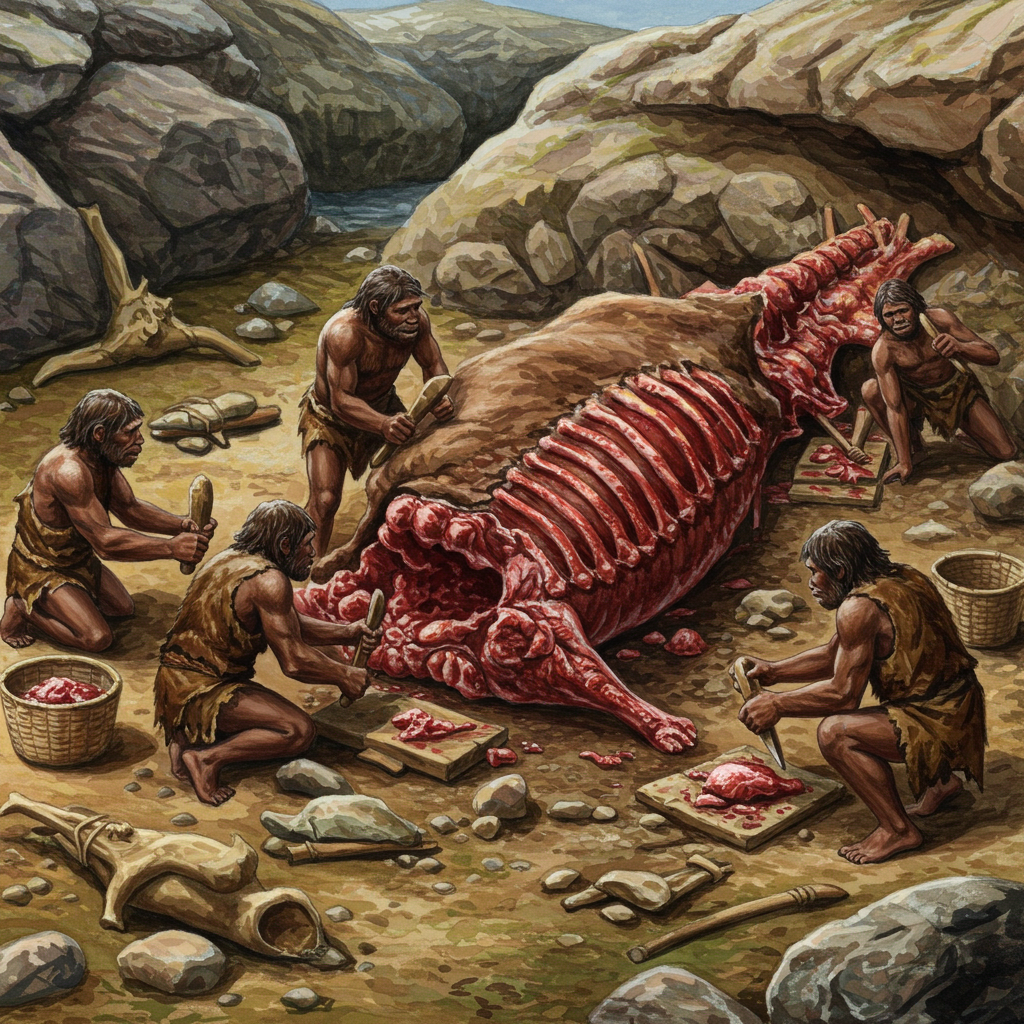Imagine a world 125,000 years ago. This was the peak of the last interglacial period, a time when Neanderthals thrived across Eurasia. Contrary to outdated stereotypes, these weren’t simple brutes. Mounting archaeological evidence reveals their complex behaviors and surprising technological prowess. A recent report highlights one such fascinating discovery: sites suggesting Neanderthals engaged in systematic animal fat extraction. These weren’t just butchery locations; they appear to be dedicated “fat factories.” This sophisticated food processing demonstrates a depth of planning and understanding previously attributed only to early modern humans. It paints a richer picture of Neanderthal intelligence and their advanced survival strategies in the harsh Ice Age environment.
Unlocking the Secrets of Ancient Survival: The Importance of Animal Fat
Why was animal fat so crucial for Neanderthals? Living in cold climates and relying heavily on large game hunting, their diet was rich in protein. While protein is essential, accessing sufficient calories and nutrients, especially during lean times or cold winters, required fat. Animal fat and bone marrow are incredibly energy-dense resources. They provide vital calories and fat-soluble vitamins necessary for health and survival in demanding environments.
Simply consuming muscle meat isn’t enough for optimal nutrition, particularly for ancient hunter-gatherers. Accessing and processing fat from bones and connective tissues would have provided a significant nutritional advantage. It allowed them to maximize the return from their hunts, ensuring less waste and greater resilience. This understanding of the value of fat and the ability to extract it efficiently speaks volumes about their ecological knowledge and adaptive capabilities.
Beyond Basic Butchery: Evidence of Advanced Processing
Archaeologists studying ancient sites look for specific clues left behind by past inhabitants. When examining Neanderthal sites from around 125,000 years ago, researchers have identified patterns far more complex than simple carcass dismemberment. The evidence for dedicated fat extraction points to intentional processing techniques.
This evidence often includes a prevalence of highly fragmented animal bones, particularly long bones and spongy bone elements like vertebrae and joint ends. These specific bones are rich in marrow and grease. The breakage patterns on these bones are key. Spiral fractures, often caused by deliberate percussion (hitting the bone with a stone hammer), suggest the intentional breaking of bones to access marrow inside. Cut marks from stone tools might show where muscle and connective tissue were removed before processing.
Reconstructing the “Fat Factories” of the Pleistocene
The term “fat factories” suggests specific locations optimized for this task. What might these sites have looked like? Archaeological findings indicate concentrations of evidence in certain areas within or near living sites. These concentrations likely represent dedicated processing zones.
Picture an area near a central hearth or fire pit. Here, archaeologists might find piles of fractured bones, stone tools used for breaking and scraping, and potentially evidence of heating. Heating bones, either by roasting or boiling, is a highly effective way to render fat. While direct evidence of boiling (like pottery or suitable stone vessels) from 125,000 years ago is scarce or absent for Neanderthals, roasting bones near or in a fire is plausible. Roasting makes bones brittle and helps release fat. The systematic nature of the bone processing at these sites indicates a planned, perhaps even communal, activity rather than opportunistic scavenging.
The Technology Behind the Extraction
Extracting fat from bones wasn’t just a matter of brute force. It required specific tools and techniques. Neanderthals were skilled toolmakers, primarily using the Mousterian stone tool industry.
Tools found at potential fat extraction sites might include:
Stone hammers: Used for breaking open robust bones to access marrow.
Scrapers: Possibly used to scrape marrow or residual fat from bone surfaces.
Knives/Flakes: For removing periosteum (the membrane covering bones) and other non-fat tissues.
The combination of these tools with the strategic use of fire demonstrates a technological approach tailored to a specific outcome: maximizing fat yield. This level of specialization in processing, focusing on a less immediately accessible resource like bone fat, is a strong indicator of cognitive complexity and advanced resource management. It moves beyond simple butchery for meat consumption.
Why This Discovery Matters: A Shift in Perspective
For decades, Neanderthals were unfairly portrayed as intellectually inferior to Homo sapiens. Discoveries like systematic fat extraction sites fundamentally challenge this view. This behavior isn’t instinctive; it requires knowledge of anatomy, understanding of material properties (bones, fat), and the ability to plan and execute a multi-step process.
This sophisticated food processing technique indicates:
Advanced Cognitive Abilities: Understanding the hidden nutritional value in bones and devising methods to obtain it.
Resourcefulness: Maximizing returns from hunting efforts, vital for survival.
Potential Social Cooperation: Large-scale bone processing might have involved group activity, suggesting social coordination.
- Technological Innovation: Developing specific techniques and tool use for a targeted outcome.
The ‘fat factories’ are not just about food; they are archaeological windows into the minds and societies of Neanderthals. They show a population capable of innovation, planning, and complex problem-solving necessary to thrive in challenging environments for hundreds of thousands of years.
Frequently Asked Questions
What is the archaeological evidence for Neanderthals extracting animal fat?
Archaeologists find evidence like high concentrations of heavily fragmented animal bones, particularly long bones and joints, at specific sites. These bones often show spiral fractures, indicating intentional breaking to access marrow. Cut marks from stone tools and signs of heating or charring on bones near ancient hearths also suggest advanced processing techniques like rendering fat. The systematic nature of these findings at certain locations points to dedicated activity zones.
What does the term “fat factories” mean in the context of Neanderthal archaeology?
“Fat factories” is a term used to describe specific archaeological locations where there is overwhelming evidence of systematic and large-scale processing of animal bones specifically for extracting fat and marrow. It implies these were not just general butchery sites but dedicated areas where Neanderthals repeatedly engaged in sophisticated techniques like bone fragmentation and potentially heating to maximize the yield of valuable animal fats for nutrition and other purposes.
Why is Neanderthal fat extraction considered an advanced technology?
Extracting fat from bones requires more than simple butchery. It involves understanding which bones are richest in fat, knowing how to break them efficiently (like creating spiral fractures), and potentially using controlled heating (roasting or boiling) to render the fat. This multi-step process, requiring specific tools and planning to access a less obvious resource, demonstrates a level of technical skill, knowledge, and foresight that is considered advanced compared to simply consuming muscle meat or surface fat.
Conclusion: A New Appreciation for Neanderthal Ingenuity
The discovery and ongoing study of Neanderthal ‘fat factories’ dating back 125,000 years is a significant step in understanding our ancient cousins. It moves beyond the outdated image of primitive cave dwellers to reveal a complex, resourceful species. Their ability to systematically extract valuable animal fat demonstrates advanced cognitive skills, technological know-how, and a deep understanding of their environment and resources. This sophisticated food preparation was undoubtedly crucial to their long-term survival in Ice Age Eurasia. As archaeological techniques advance, we continue to uncover more evidence of Neanderthal ingenuity, cementing their place as highly capable members of the human story. Future research at these ancient sites promises to reveal even more about their daily lives, social structures, and technological capabilities.




